Walnut Lane
PA, USA
‘A good course will make you use every club in your bag.’ This expression has been repeated so often it has become a cliche, but its general premise still rings true: A complete course will test every aspect of a player’s game.
Where, then, do you find such courses? Are they the ones that host professional major championships? Sometimes. However, courses of all shapes and sizes can meet this important characteristic if designed well. Take Walnut Lane, a par 62, 4510 yard municipal course in Philadelphia.
When a friend of one of the authors invited him to join him for a winter round there, the author admittedly hesitated before driving two hours each way to play a par 62 municipal course in cold weather and average to poor course conditions. As it turned out, he was quite glad he made the trip. An immediate show of support for Walnut Lane was that the author was greeted there by members of Huntingdon Valley and Rolling Green, each of whom proclaimed Walnut Lane to be his ‘winter club.’
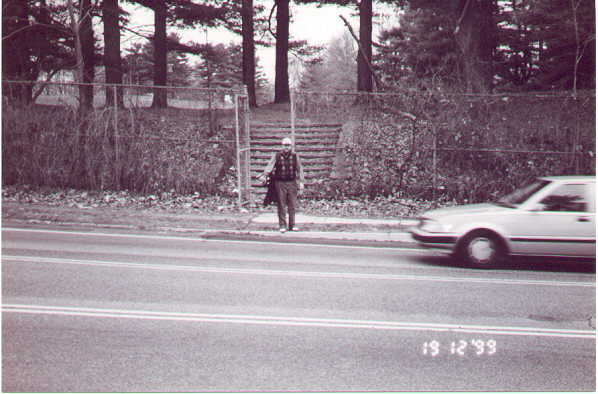
Similar to another course in the Philadelphia area, Walnut Lane is divided by a busy public road.
The author’s friend had promised him he would use every club in his bag, and, on the drive home, the author went through his round and realized how right his friend had been: he had played a full stroke (i.e., not counting chip shots) with each of his 13 clubs plus his putter! In fact, the author cannot think of another course where that was so true. Why is it so at Walnut Lane? Its configuration of ten one-shot holes and eight two-shot holes contributes greatly. What better way to force a player to play from certain distances than with one-shotters? At Walnut Lane they range from 135 yards to a full 235 yards. The two-shotters are surprisingly short, in the 320 “ 370 yard range, but the player’s long clubs are given quite a work out on the one-shotters, where four exceed 190 yards.
To illustrate a typical round at Walnut for a single digit handicapper (note that there are some elevation changes involved):
1st hole, 325 yards: 3-wood, sand wedge;
2nd hole, 195 yards: 3-iron;
3rd hole, 320 yards: driver, lob wedge;
4th hole, 230 yards: 4-wood;
5th hole, 200 yards: 4-iron;
6th hole, 175yards: 5-iron;
7th hole, 370 yards: driver, pitching wedge;
8th hole, 360 yards: 3-wood, 9-iron;
9th hole, 235 yards: 3-wood;
10th hole, 155 yards: 7-iron;
11th hole, 335 yards: 4-wood, 9-iron;
12th hole, 340 yards: 3-iron, pitching wedge;
13th hole, 140 yards: 7-iron;
14th hole, 335 yards: 3-wood, sand wedge;
15th hole 135 yards: 8-iron;
16th hole, 160 yards: 6-iron;
17th hole, 340 yards: driver, 9-iron;
18th hole, 150 yards: 7-iron
Holes to Note
First hole, 325 yards; Right away it is evident why winter is the time to play the Lane. A look down the bowling alley fairway with trees overhanging the sides makes one wonder if the course is playable in the summer.
Fifth hole, 175 yards; One of the first dog-leg one-shotters, where a large tree on the left can make a draw mandatory for attacking a left hole location. While such a ploy can seem silly, it seems very appropriate at Walnut Lane.
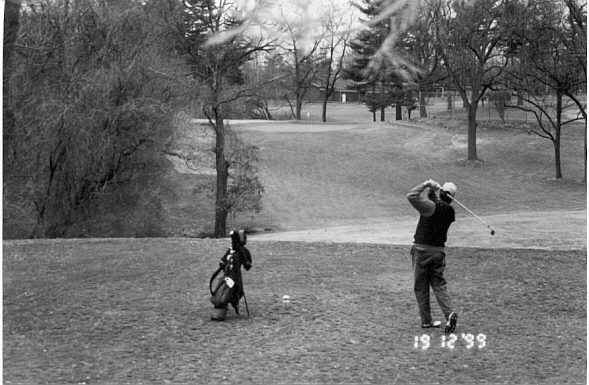
The tree guarding the left side of the 5th green.
Eighth hole, 360 yards; The author’s favorite hole and the most strategic on the course, the 8th forces the player to flirt with the drop-off to the left (down to the 11th fairway) or have to negotiate with his second the trees on the right side as the green is tucked around the corner to the right. A swale left of the green catches many balls that are played from the right side but without enough of a fade.

Even though he is in the fairway, this player must fade his second to the 8th around the trees as he is on the right (wrong) side of the fairway.
Twelfth hole, 340 yards; The most natural and visually appealing hole on the course, the 12th merely cascades down the hill to its green at the bottom, just shy of a creek. The creek on the left side of the fairway and rock ledge on the right frame the natural location of the fairway. In firm conditions, players are tempted to take a crack at this green from the tee, but there is plenty of trouble to find as the creek wraps its way around three side of the green. The clever ridge in front of the green (which was put there probably just to keep the water from draining straight down the fairway and onto the green) gives players fits with even short pitches, especially to front hole locations.
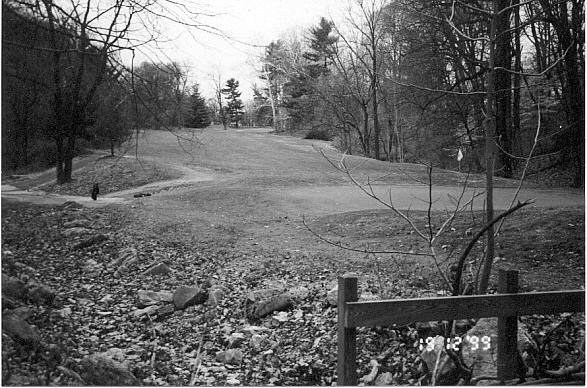
Looking back up the 12th from the creek.
Fourteenth hole, 335 yards; The most heroic hole on the course, the 14th dares the player to cut off as much as he can of the wooded chasm on the left on this dog-leg left. A bold shot with a driver can leave a little flip with a lob wedge while a fairway wood or long iron will leave a full short iron, albeit from a level stance. Whatever club the player selects, there is a specific line for that club, as the fairway angles away from the player, and it is quite easy to wind up through the fairway and behind a tree. The approach is most appealing, to the green perched on its shelf.
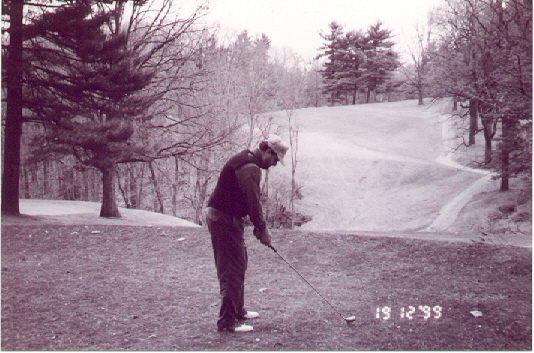
The dramatic and strategic tee shot on the dog-leg left 14th.
Why is it that Alex Findlay’s work at Walnut Lane is not better known? First, the course conditioning suffers tremendously (although a new management firm has taken over since the authors were last there and conditions might have improved quite a bit). There were times when grass was in the minority for surface coverage on some greens. Second, it’s a par 62 course, causing many snobs to pass it by. Third, it is a municipal course, again causing many golf snobs to give it little thought. However, this last point is one very good reason to seek it out, as municipal courses can often offer the best glimpse as, unlike private clubs, they typically lack the funds to destroy the course by rebuilding greens, adding bunkers, planting trees, etc.
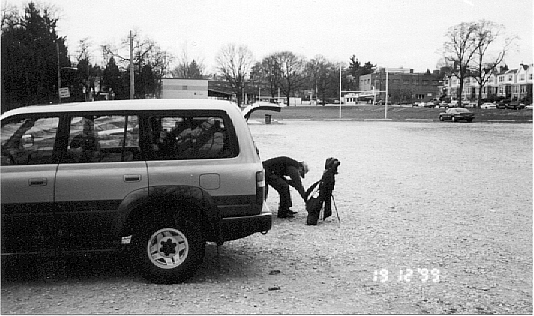
Part of the Walnut Lane experience: The locker room.
Another pleasant aspect of Walnut Lane is that it lies in a park. It is not unusual for a player to have to back off a putt as kids on dirt bikes attack the rough trails. The players park next to a soccer/football field (almost on it, in fact). To round out the experience, though, the player must duck around the corner afterwards to sample a true Philly cheesesteak sandwich.
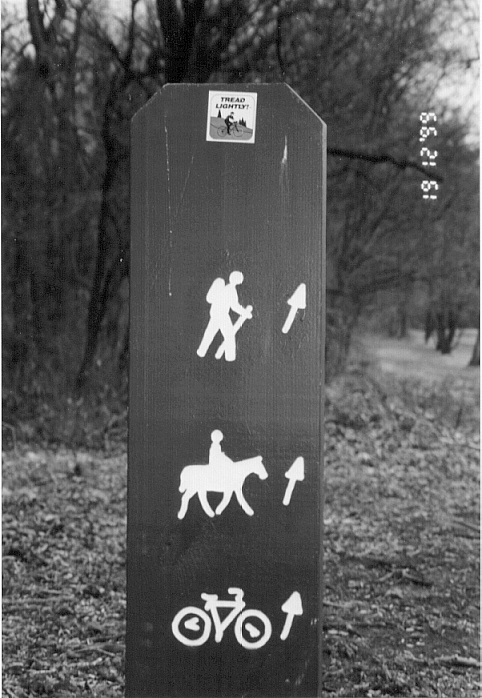
This sign between the 3rd and 4th holes ensures the player won’t be side-tracked on a horse trail.
The End

